Terrariums are a wonderful way to green up your home with very little maintenance. True terrariums, with covered tops, and self-contained ecosystems are a fun botanical experiment too. There are a few general benefits to using terrariums as houseplant containers, but the most important are heat and humidity.
Any plant that likes controlled, constant conditions, will adore terrariums. In this guide, we’ve put together a list of terrarium plants that work beautifully,, but once you get started, don’t be afraid to experiment with weird and unusual combinations!
More...
What is a Terrarium?

A terrarium is a closed, or partially enclosed glass container used to grow plants. Those plants can range from mosses to bonsais, or more ornamental flowers like orchids and vibrant foliage plants like Fittonia.
Essentially, what you’re creating is a humid, warm environment, insulating the plants from changeable house temperatures with glass walls surrounding them, and boosting that further if you choose to cork or seal the top.
If you get it just right, your terrarium can go for decades without ever needing moisture adding in. If you prefer to play things by eye, then open-top terrariums allow more attention to watering and offer a slightly wider range of potential plants that prefer lower humidity.
What Makes a Good Terrarium Plant?
Any plant that enjoys humidity and grows on fibrous roots can be grown in a terrarium. They must be able to cope with shallow soil, and ideally be used to climates where temperatures don’t vary very much from season to season, as the glass container will regulate them to a reasonable average throughout the year.
Soft stemmed vining plants work well in terrariums too, often filling the entire space and regenerating when older leaves die back, feeding from fallen leaves, while the moisture in the closed terrarium is enough to create a circular microclimate.
What Type of Plants Grow Best in Terrariums?
Tropical and subtropical ground-level plants, rather than epiphytes or rhizomatous tropical plants, tend to grow best in terrariums. Any herbaceous perennials can struggle thanks to the higher humidity, which can rot any dormant crowns over winter.
In short, evergreens are ideal, and anything that grows through constant, non-dormant seasons, will be the best type of plant for your terrarium.
How to Set Up Your First Terrarium
Setting up a terrarium is actually pretty simple, and depending on the plants you’re growing, and how dedicated to ‘true terrariums’ you want to be, there are many variations on these simple enclosed planters.
Key terrarium principles
The key principles of any successful terrarium are enclosure, circulation, insulation and soil layering.
Enclosure
Terrarium plants should not be allowed to grow out of their container, as they will be humid at the base but dry at the top. This can create fungal problems and negates the purpose of the terrarium as an insulator.
Circulation
Rounded vessels will drip water back into the soil when it evaporates, so even open-topped terrariums have some recirculation of moisture to stop plants from drying out. Capped terrariums are much more effective at this.
It’s also important to avoid terrariums with split bases, such as domes over wooden bottoms, or where the outside dome is wider than the inside dome, as any moisture will drip down away from the soil.


Get Your Free Guide:
Master Growing Australian Natives eBook
A Must Have Complete Guide for Every Australian Garden
Get Your Free Guide:
Master Growing Australian Natives eBook
A Must Have Complete Guide for Every Australian Garden
Insulation
The thicker your glass, the more effective your terrarium will be. It’s not just about keeping heat in, it can regulate both ways, by slowing down overheating, and retaining cooler conditions in terrariums placed away from direct sunlight.
Soil layering
Soil layering is essential for a healthy terrarium. Think of your plant’s natural needs. They require some organic matter to root into and hold onto any moisture and nutrients, but also a drainage layer so that their roots are protected from any excessive moisture after watering.
Water should be drunk up by terrarium plant roots quite quickly, and they will transpire if they have too much. Open-topped terrariums are easier to manage in this respect.
See our in-depth guide on how to make a terrarium which includes a list of DIY terrarium kits and ideas to choose from.

Making a Terrarium
The most basic terrarium you can make at home just needs an old glass coffee jar, some clean grit, and a layer of organic compost.
Materials
- A glass coffee jar, with sealable lid (or any other thick glass jar)
- Horticultural grit (fish tank stones will work)
- Clean compost
- Plants (see the list for the best options)
Method
- Start by scrubbing off any labels, and clean out your jar. It sounds obvious, but it’s important to do it now because it will be impossible later.
- Pour in a 1 cm layer of grit, followed by a 2 cm layer of compost (or enough to cover the existing root ball of your plug plants).
- Using a pencil, scrape a hole in the compost.
- Gently (using tweezers or pliers if you can’t fit your hand in) place your first plant into the hole. And repeat with any additional plants.
- Tease the soil back around the base of the plant, leaving it slightly proud of the soil surface.
- Pour in a small layer of grit to keep any excess moisture in the soil away from the base of the plant and prevent damp damage.
- Add a very limited amount of water, just until the compost is slightly moist.
- Seal the top.
After that, you just need to pay attention to your terrarium for the first few months. If it needs more water, add it bit by bit, making sure not to over-saturate. In time, the terrarium plants will root as far as they can, and growth will slow down.
Keep the lid sealed unless you need to water, which may be never…
30 Best Terrarium Plants to Choose From
1. Clubmoss (Lycopodiopsida)
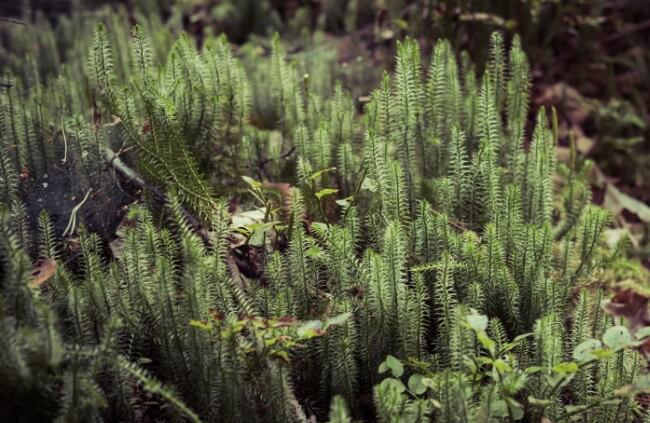
Lycopodiopsida were once one of the most dominant genera on planet Earth, with some species that create tall forests of lycopods. They are somewhere between a moss and a fern, with upright stems and branching forms that produce spores to enable reproduction.
Today, there are no giant lycopods left, but the dwarf forms that exist are probably the easiest terrarium plants to manage, offering something a little bit different to more ornamental displays in open terrariums, and more than capable of producing their own living ecosystem in humid closed terrariums.
2. Nerve Plant (Fittonia)

Fittonia are great for any type of terrarium, and easy to manage. They enjoy moist soils and humidity, so it is possible to grow them in closed terrariums, but if they go without water for too long they fade and wilt completely.
However, what is fascinating about Fittonia, is that they will respond to watering from dry, dead-looking plants, within a matter of minutes. We once bought a ton for literally pennies that the garden centre thought had died and planted up terrariums and bathroom displays with them.
Six containers filled with mixed Fittonia must have cost us about three dollars.
3. Air Plants (Tillandsia)

Tillandsia, more commonly called air plants, are true epiphytes. They can grow without any anchorage, simply placed on the bottom of a clear terrarium and misted, or hanging from a wire in a sealed terrarium in a bright spot with dappled shade for a self-sustaining system.
Tillandsia are part of the large bromeliad family, and look very similar, but have adapted leaves, usually with light fur to hold onto any natural humidity.
One benefit of growing them in open terrariums, despite more regular maintenance, is that they can be removed and fed in a very diluted liquid fertiliser (use one or two drops in a bowl of water and submerge for five minutes).
4. Peperomia

Not all Peperomia is suitable for terrariums, but some of the smaller varieties and low-growing or trailing types are ideal. They like humid conditions, and moist compost, so as long as you remember to add a healthy layer of grit to the base of your terrarium to keep roots from sitting in water after planting, they should last in terrariums for years.
If peperomia outgrow their space, they can be prudent with good effect.
5. Begonia

Begonia is a very wide group of plants, but one that does offer a lot of potentially suitable plants for terrariums. In fact, one of the most impressive terrariums I’ve ever seen was a 1.5m3 glass tank, planted entirely with tropical, forest floor begonias.
When selecting begonias for terrariums, choose those with textured foliage, and slow growth. They tend to be more suitable to high humidity.
6. Pothos
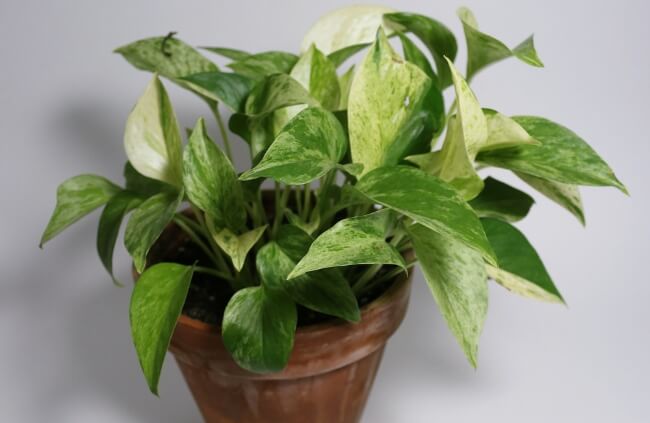
Pothos are generally too large for terrariums, but if you’re aiming for bold design choices, this would definitely fit the bill. A single pothos, with grit and compost under a moss base can last well in a large sealed terrarium, and with the right tools, damaged sections can be pruned out and pulled through the lid.
Even in mixed terrariums made from a typical fish tank, pothos can make a wonderful base for other planting.
7. Button Fern (Pellaea rotundifolia)

Pellaea rotundifolia is, in theory, a very good plant for terrariums. I must confess that I have never had any luck with it, as it tends to be slow to establish and the moisture doesn’t agree with non-established ferns.
If you can get your button fern to establish, possibly in an open terrarium, it will last for years, even if you later seal it.
8. Creeping Fig (Ficus pumila)

Creeping fig can be grown as part of a mixed terrarium, but with ventilation, so never in a closed terrarium. The variegated leaves of some cultivars are just stunning, whether you stick strictly to the method of terrarium, or simply use your glass container to start things off.
9. Strawberry Saxifrage (Saxifraga stolonifera)

Strawberry Saxifrage is one of the easiest plants for any terrarium. It loves shady humid conditions, and can compete with other plants if it is planted in with moss, producing stolons (runners) that can root and produce new plants from young leaves that develop (similar to how strawberries develop).
10. Houseleeks (Sempervivum)

Sempervivum, one of the most popular succulents in the world, are easy to grow in most settings, and in an open terrarium, with a free draining gravelly mix on the base, they can really shine.
A few young sempervivums taken from pups and dotted around the base or a terrarium can quickly fill it up, but will need regular management to remove flowering plants (they die after flowering,and are replaced by adjacent pups).
11. Dwarf Orchids

There are swamp and bog orchids found all over the world, and the orchid genus is potentially, despite appearances, one of the most resilient groups of plants there is.
With some orchids reaching no more than 1 cm tall at maturity and growing happily on humid bark, or even hessian, it’s easy to establish a dedicated orchid terrarium provided you do a little bit of research about varieties first.
12. African Violet (Saintpaulia)
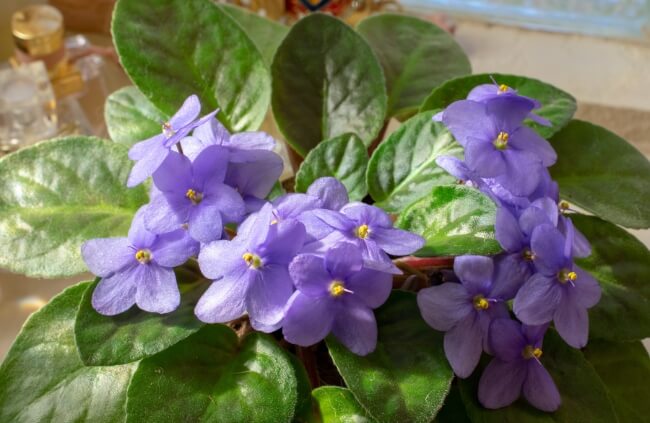
African Violet is a gorgeous terrarium plant, but please ignore suggestions online of planting these otherwise tough houseplants in a sealed container. They need to breathe, and benefit hugely from the moisture and humidity of open terrariums, but the ventilation is essential to prevent rot around the base of these flowering herbaceous plants.
13. Living Stones (Lithops)
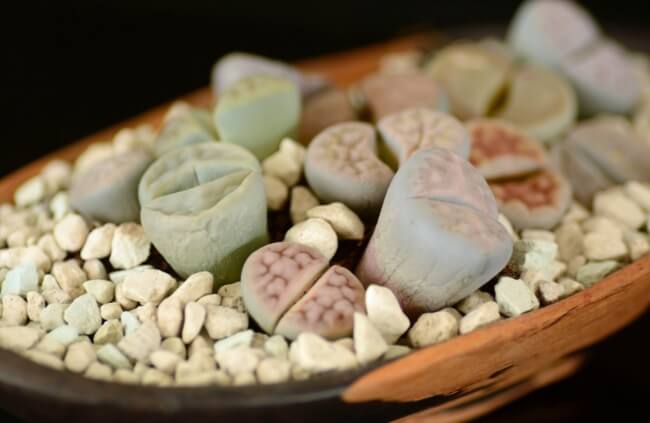
Lithops, if we’re honest with ourselves, are funny-looking plants. You know exactly what I’m talking about, so don’t shy away from it. But, despite their cheeky appearance, they do make good plants for open terrariums, which act as heat sinks from these drought tolerant living stones.
They should be placed somewhere warm, bright, and in full sun, where they can be allowed to dry out completely, so an open terrarium is essential. Plant them into gritty compost or even pure grit.
14. Pilea
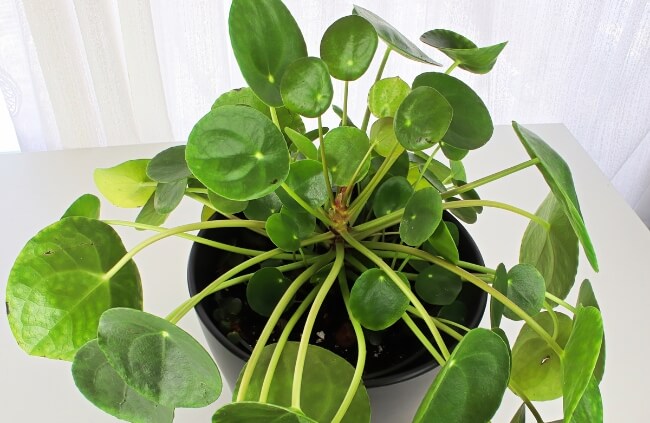
Pilea is a moisture loving group of plants, split into about 700 distinct species. As with any large genus, guidance on care for each will vary, but on the whole, they are easy-going, moisture loving tropical plants, and some with smaller leaf forms like Pilea glaucophylla, or Pilea involucrata, are very, very useful filler plants for terrariums of all types.
We have a paludarium (a terrarium with water) here, which is mostly planted with smaller cultivars of Pilea involucrata, growing from branches. Running water provides constant humidity but the tank is slightly ventilated.
15. Haworthia

Haworthia is a succulent, and it looks like it could cope with some serious drought, but we’ve actually found it grows best in open terrariums, where humidity and moisture circulate. Even if that terrarium isn’t a true terrarium, and just functions as a curved glass pot to maintain even moisture around the roots.
Dry haworthia tend to wilt and rot from the centre if you water them too quickly and generously after drying out, so simple open terrariums do help.
For something a bit different, check out Haworthia cooperi var. truncata, which shows you exactly how much moisture it’s holding thanks to nearly transparent leaves.
16. Earth Stars (Cryptanthus)
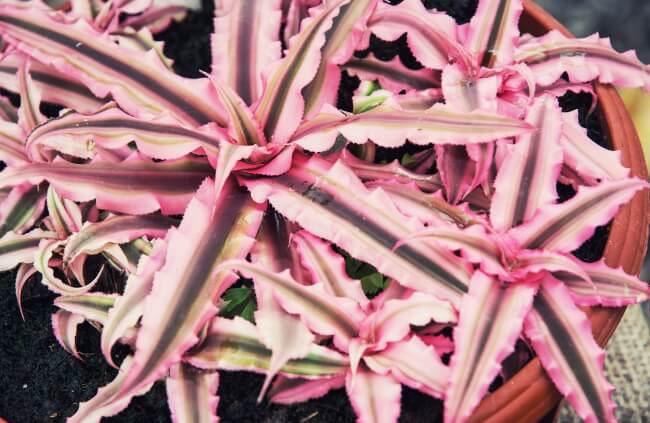
Another Bromeliaceae genus that works well in terrariums, either open, closed, or partially ventilated, is Cryptanthus. Its fine foliage and bright colours pop out from the crowd, and it’s fairly easy going provided its roots are never sat in wet compost.
Consider attaching this lithophyte to a piece of bark within a humid terrarium.
17. Spikemoss (Selaginella)
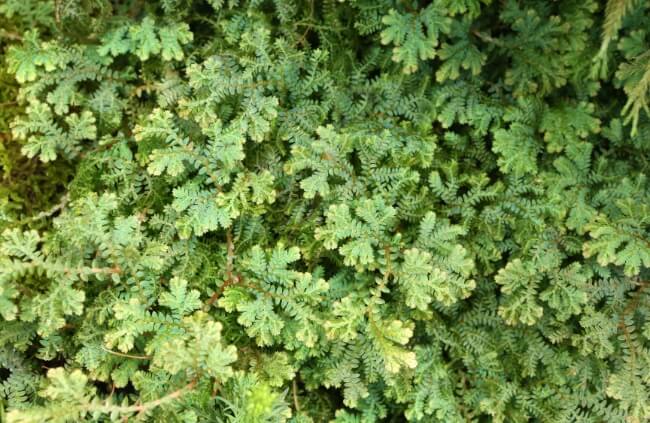
Confusingly also referred to as lesser clubmoss, spikemoss is one of the most wonderfully unusual plants you can grow in terrariums. It thrives in open or closed terrariums and its only real requirements are sun and humidity.
It’s scaled and grows almost like lichen, in branching forms. A single section of Selaginella (spikemoss) can fill a terrarium in no time.
18. Pincushion moss (Leucobryum glaucum)
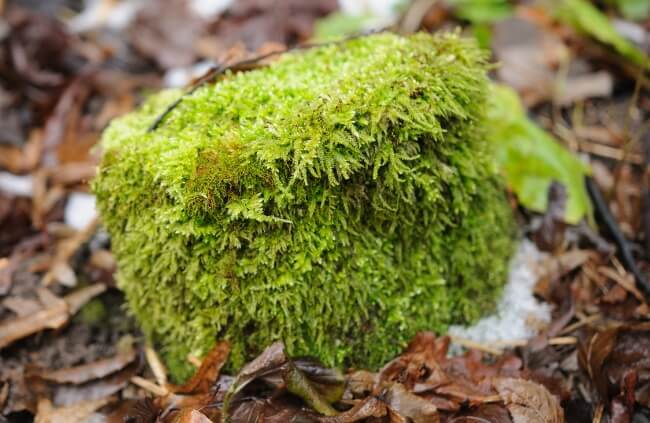
Leucobryum glaucum, or pin cushion muss is the perfect base for any mixed terrarium and works just as well by itself. It grows in tight mounds, and when two meet they form crisp hills and fascinating natural mini landscapes.
Pin cushion moss grows well in both open and closed terrariums.
19. Baby Tooth moss (Plagiomnium cuspidatum)
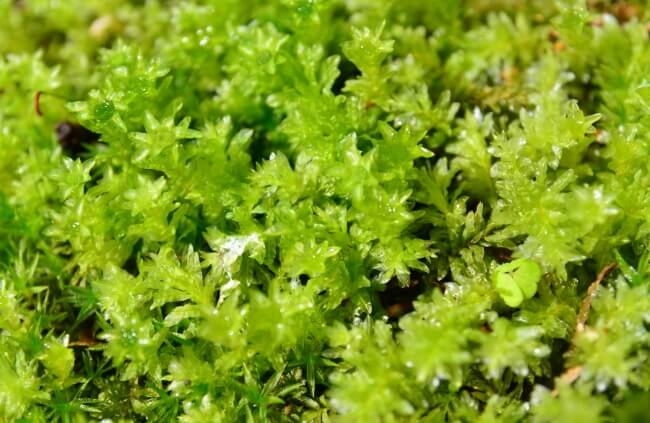
Plagiomnium cuspidatum, commonly called baby tooth, or toothed moss, is a species of thyme moss that grows around the base of trees, and pretty much any highly humid, damp spot, where they can take moisture from other sources.
In closed terrariums, it will form a rich ecosystem all by itself, and is thought to be one of the easiest plants to sustain in a terrarium.
20. Hart's-tongue Thyme-moss (Plagiomnium undulatum)

Source: NatureSpot
Another thyme-moss, Plagiomnium undulatum, or Hart’s-tongue moss has much deeper texturing along distinctly trailing branches. It will grow on forest floors, and thrives in rich environments filled with organic matter.
If grown in a terrarium it may need feeding, but will also produce its own fertiliser as sections fade, and are replaced by new growth.
21. Swan's-neck Thyme-moss (Mnium hornum)
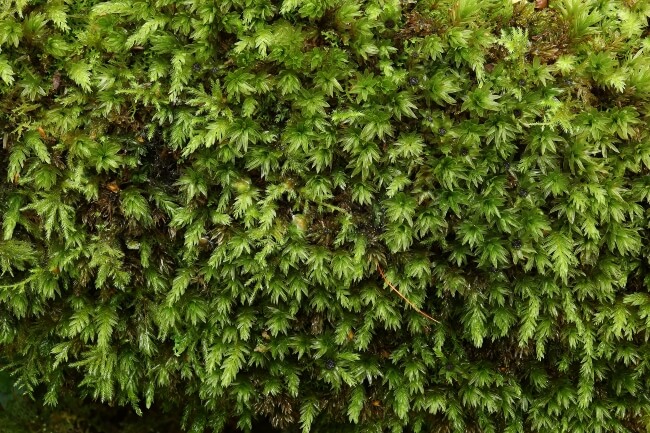
Source: British Bryological Society
A very common moss in temperate climates is Mnium hornum, which can pretty much be found growing on any stone wall and planted into a terrarium with any substrate.
For a truly fool-proof terrarium plant, Swan’s-neck thyme-moss is basically guaranteed to work and develop into a densely spread terrarium plant.
22. Knight’s plume moss (Ptilium crista-castrensis)
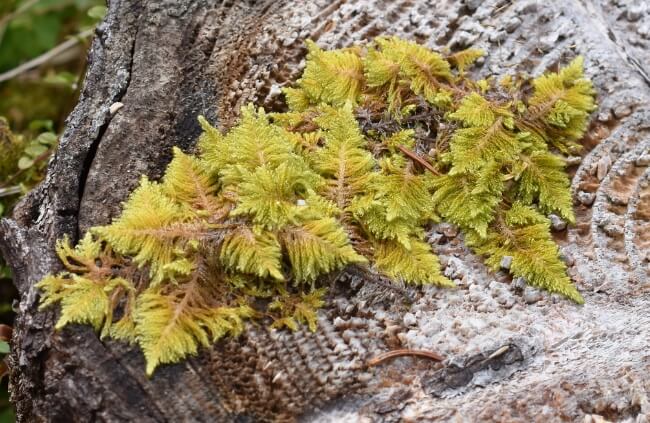
Ptilium crista-castrensis, otherwise called ostrich-plume feathermoss or knight’s-plume offers the illusion of tiny ferns, without the potential size problem that many terrarium keepers worry about.
The pointed fronds stand upright from their growing medium (ideally some bark) and end up doing best when grown in a semi-ventilated terrarium.
23. Rainbow Marcgravia (Marcgravia sintenisii)
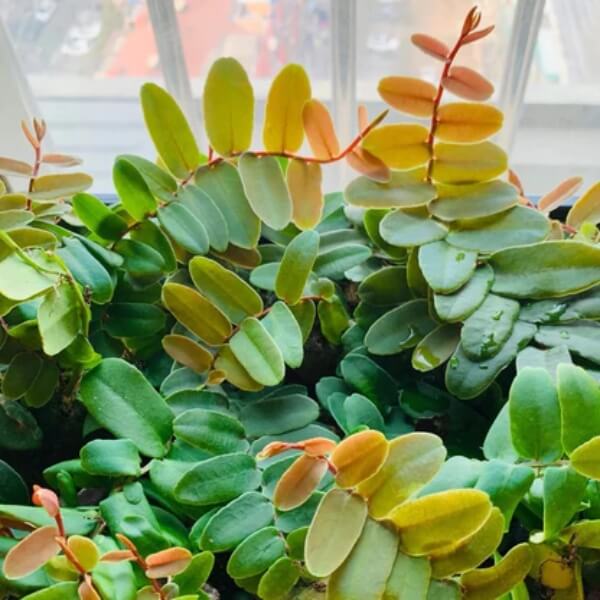
Source: My Home Nature
The South American forest climber, Marcgravia sintenisii, offers colour and interest to terrariums of all sizes, but is best suited to larger terrariums where it enjoys any above average humidity, but does need a soil substrate to root into.
New growth at the tips of the vine is orange and salmon-toned, while the waxy foliage at the base builds into glossy emerald tones.
24. Peacock Spike Moss (Selaginella uncinata)

Selaginella uncinata is a particularly well suited cultivar of spikemoss for terrariums. It quite happily tails, and coats other surfaces, so for more ornamental or landscape terrariums - those in fish tanks in particular, it offers an easy way to tie in other planting, and hide structural features like bark pieces or rocks.
25. Humata heterophylla
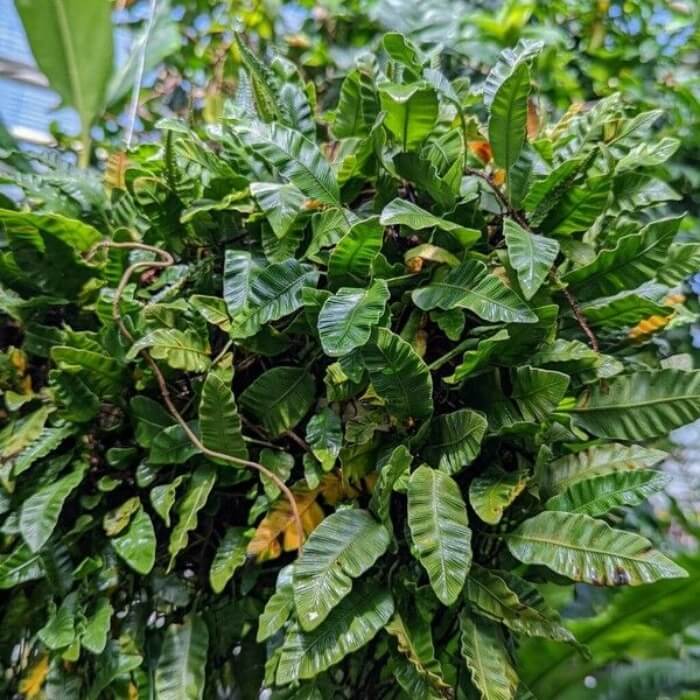
Source: Plant Identifier - Plantnet
While it can become very large outdoors, Humata heterophylla, the vining fern, will only grow to fill its container. That means it is ideally suited to terrariums and will maintain smaller foliage, with more compact rhizomes.
They are distinct from most other ferns in that they do actually form vines, which creep along the soil surface, rooting in to form other plants from the base of each leaf. Those vines can crawl up bark, or along flat surfaces, creating natural-looking terrariums in no time.
26. Mini Asian Water Fern (Bolbitis heteroclita ‘Difformis’)
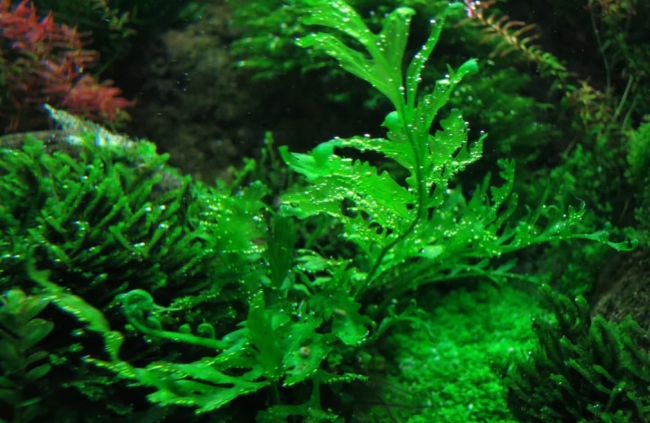
Source: The Guppy Garden
Bolbitis heteroclita ‘Difformis’ might be called the water fern, but it can be grown on dry land. Perhaps the best way to keep it through is in a very humid, enclosed space, like a closed terrarium, which quickly adapts and develops into a stunning upright fern that won’t outcompete other plants.
Perhaps the simplest example of companion planting in any terrarium I have seen was the mini Asian water fern and spike moss. The two together were all that was needed to create a truly dream-like scene.
27. English Ivy (Hedera helix)
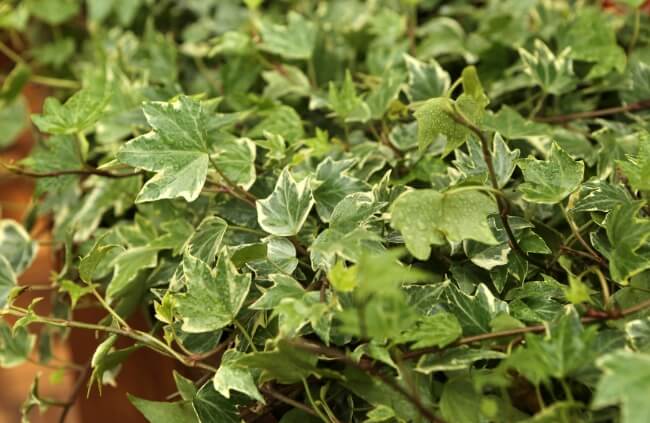
There are many cultivars of English ivy (Hedera helix), but small leaved varieties in particular do very well in terrariums. They will need some stone or bark to climb up but thrive on the naturally increased humidity of open-topped terrariums, where they can be pruned regularly to maintain their size.
28. Baby’s tears (Soleirolia soleirolii)
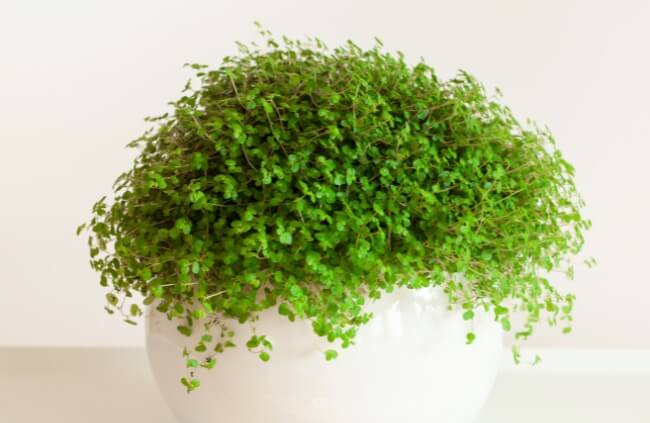
Baby’s tears (Soleirolia soleirolii) is a tough, moisture-loving plant that works as a thuggish ground cover outdoors and grows wonderfully up walls and through paving.
My favourite of its common names is ‘Mind-your-own-business’, which perfectly defines how intently intrusive it can become, but when planted in a terrarium its growing space is limited, and its humidity is circular, creating ideal conditions for limited but constantly green growth.
29. Spider plants (Chlorophytum comosum)
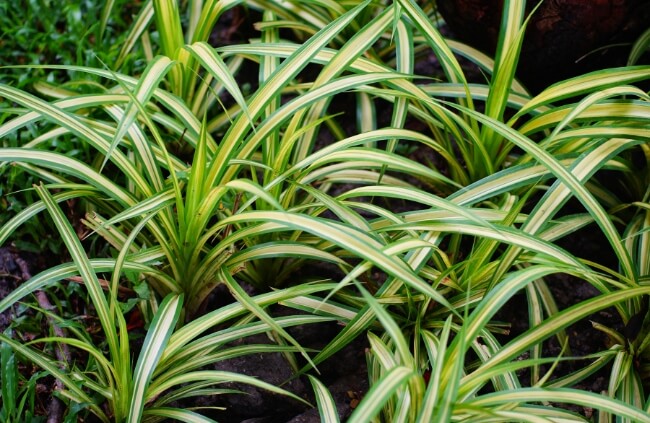
For larger terrariums, spider plants offer a simple solution for filling space, but they do require ventilation and reasonably good lighting to maintain any sort of healthy vigour.
The easiest way to know if your terrarium spider plant is happy is if it has pups growing from hanging stems. Happy spider plants will nearly always be in a constant state of reproduction.
30. Maranta
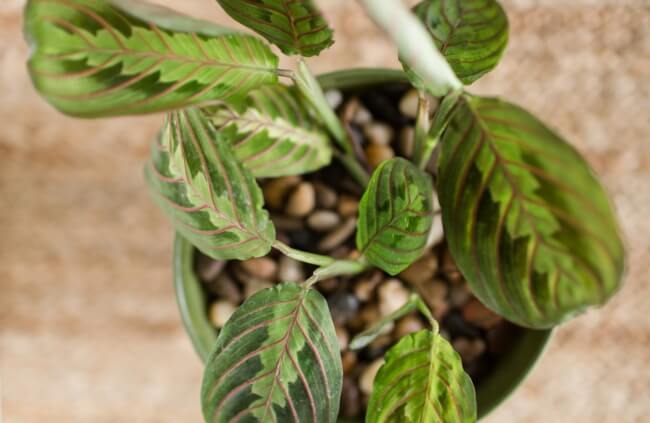
Most lists of terrarium plants suggest ‘Prayer Plants’ as terrarium plants, but it is important to provide a distinction between the different types of prayer plants. Calathea for example, the most common prayer plant, does not work at all in terrariums. The humidity rots the roots quite quickly.
Maranta is compact enough and tough enough to cope with open terrariums and makes a great statement for the centre of a terrarium arrangement, but no prairie plant is a good long term choice for a terrarium.
Common Problems When Growing Terrarium Plants
Any problems that happen in a closed terrarium can be hard to solve, but it’s never impossible. In open terrariums, you can treat your plants as you would with any other house plants, and assume that the most likely problem is over-watering or excess humidity caused by the enclosed space.
Some very specific problems that are common when growing plants in closed terrariums include getting too hot, and some that are simple as choosing the wrong plants to start with. Troubleshoot some of the most important problems below.
Terrarium is too hot
If your terrarium is too hot, it will quickly tell you, with constant mist on the glass, and wilting plants. Remember, you’re creating a tiny greenhouse here, so if it’s in direct sunlight, or near a radiator, it can overheat easily.
Overwatering
Overwatering your terrarium is easy to do, and hard to resolve, as you can’t exactly tip it out without damaging the plants. Instead, move your terrarium somewhere warmer to help it dry out for a few days, with the lid off. Once it’s dried out, try to re-establish the right moisture levels.
Too bright or too shaded
Terrariums can cope with partial shade, and some plants will thrive in it, but in general, they do need some sunlight throughout the day. Avoid direct afternoon sun or bright window sills, as this can overheat terrariums.
Table tops, or shelves that are about 2 m away from a bright window should help to balance light and heat levels for your terrarium.
Over feeding
Closed terrariums don’t need feeding, but open ones do. They allow plants to develop more vigorously, and plants will likely need cutting back.
Feed very sparsely using a liquid fertiliser, rather than slow-release granules, which will offer little nutrition as they break down slowly in the enclosed space.
Choosing the wrong plants
The impact of using the wrong plants in your terrarium, or having bought a pre-planted terrarium with the wrong plants already in it, shouldn’t be understated either.
For example, it’s become increasingly popular to plant rubber figs and bonsais in terrariums, but you have no control over root pruning in these conditions, and they will either die or break your terrarium.
Equally, aerial root plants like Monstera (even dwarf varieties) will struggle in a terrarium. They need to climb and spread and will smother other plants. The same goes for clump-forming plants like peace lilies and any aroids, which naturally spread.
Any plants that really dislike humidity are a bad choice for terrariums too, as even open-topped terrariums trap humidity around the base of your plants.
Frequently Asked Questions About Terrarium Plants

Do terrarium plants stay small?
Some terrarium plants naturally stay small or grow to fill the space they are given. Mosses are a great low-maintained option if you’re worried about your terrarium plants getting carried away.
What plants can you put in a terrarium without soil?
Tillandsia, also called air plants, will grow happily in a terrarium without soil. They feed entirely on moisture in the air but do require feeding from time to time with a foliar spray. They are easy to manage and don’t require any growing medium, whether they are strung up, or left sitting at the base of a misted terrarium.
How long do terrariums live?
If you care for your terrarium properly there is no reason that it shouldn’t outlive you. One terrarium, widely considered to be the oldest in the world, is a moss terrarium that’s around 70 years old, and still going strong.
How often do you need to water a terrarium?
A typical terrarium with a loose lid, or cork lid, will need watering once every few months. Less than most house plants. A completely capped terrarium should never need watering but will take a bit of time to establish before you can seal the lid.
What is the easiest plant to grow in a terrarium?
The easiest plant to grow in a terrarium is moss. No matter what anyone else tells you, it will work, it will look good, and it can be used to create wonderful miniature landscapes with ease.
Carnivorous plants and cacti are, despite some claims, distinctly bad to grow in terrariums, which would either over-humidify them, or remove their primary food source.
Wrapping Up Our Guide to Terrarium Plants
Terrariums aren’t easy to establish if you want to build them properly, but there are quick ways to hack the system and make beautiful planting arrangements look even better with open-top terrariums.
If you do manage to get the right plants for your terrarium and set it up properly, you’ll have a self-sustaining ecosystem that requires very, very little care.
Published on October 11, 2023 by Maisie Blevins
Last Updated on October 18, 2024




